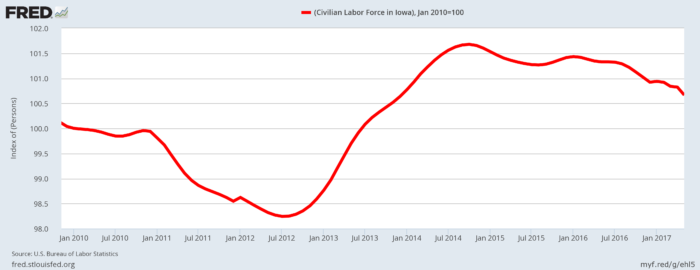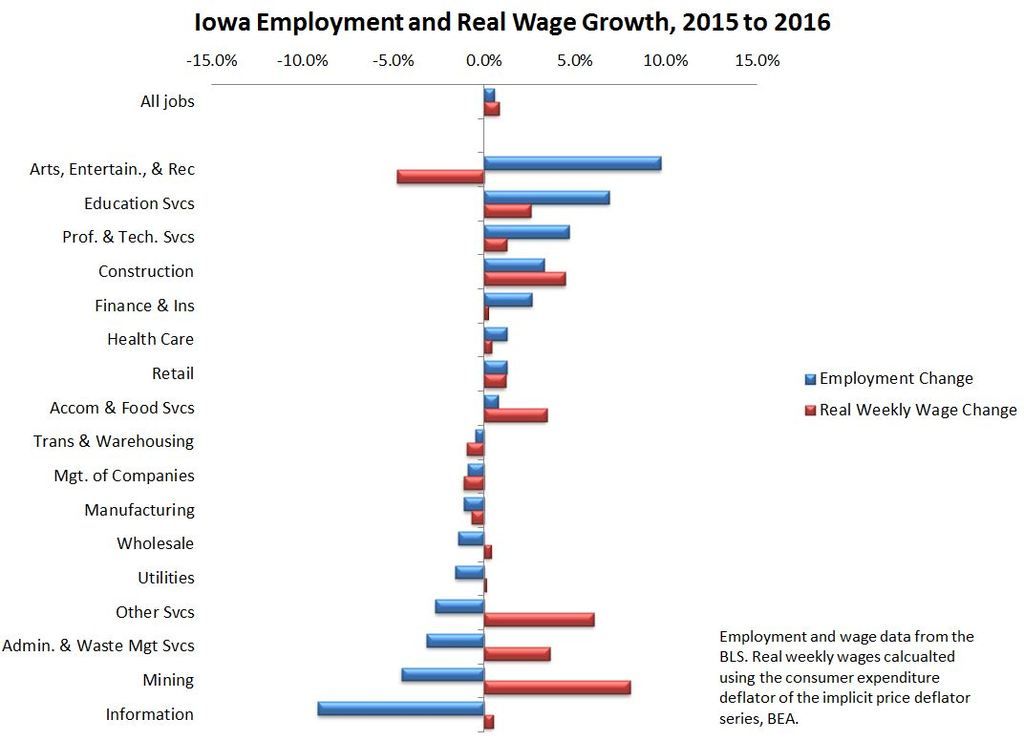Economist Dave Swenson explains why “a tight labor market is good for workers and good for families,” contrary to what you may have read in the newspaper. -promoted by desmoinesdem
Iowa’s enviously low unemployment rate of 3.1 percent is distressing many in the business community and, by proxy, business news. In recent months more and more people are declaring that Iowa is at full employment, and that, they say, is a problem.
It’s not. Iowa’s economy bumping up against full employment, if in fact that is happening, is a good thing. It is the stated goal of every politician’s overweening job creation rhetoric. It is what we hope for as our economy moves through the wrenching disruptions to firms and households caused by recessions. It is precisely what we want to happen: as many people are working as our economy can support.
Unless it creates discomfort in the business community. Then low unemployment is a problem. Let me explain.
When unemployment is low, it is true that businesses will find it harder to fill jobs at current rates of pay. That is inconvenient. It also means that the available labor pool is thinner in terms of skills, experience, and knowledge. Remembering our Economics 101, the recourse for employers as competition for skilled talent increases is to boost pay. Higher wages send a potent signal to workers in other industries, in other states, and to the labor market as a whole. Businesses are reluctant, like they are with any cost, to boost pay.
So they complain that there is something wrong with the economy when, in fact, the economy is just fine.
Is there evidence that Iowa is actually at full employment? Not really. If we were, we’d see wages bid up across the board, and consistently so in fast job growth sectors. Instead, we see a very inconsistent pattern of wage growth that does not correlate with employment growth rates.
The figure below illustrates recent change. Real (adjusted for inflation) weekly payrolls in Iowa grew by 0.8 percent on somewhat weak job growth of 0.6 percent for 2016. Arts, entertainment, and recreation jobs grew at the highest rate, but real weekly pay went down at the highest rate. Reasonably strong job growth in education services along with professional and technical services all translated into boosted real earnings. Accommodation and food service jobs grew by 0.8 percent, but real weekly wages went up by 3.4 percent. Strong job growth in the finance and insurance sectors yielded annual weekly wage growth less than the overall state average, and the manufacturing sector both contracted in jobs and in real wages, though it is in manufacturing where we hear the most worker shortage laments. The construction industry, which has in fact boomed in Iowa (pipelines, windmills, metro housing and commercial growth, pent-up road building and repair, fertilizer plants, etc.), posted strong employment demand and strong wage growth.
You get the point, don’t you? There’s really no evidence of systematic labor shortages, or if there are, businesses are yet to address those shortages with meaningfully higher wages in most sectors of the Iowa economy.
Where does that leave us? It first must be acknowledged that the state in fact has a flat-to-declining labor force, according to my own research. Many more people are exiting the labor force than entering due to Baby Boomers retiring in increasing numbers. To this point, April’s labor force was down by nearly 9,000 from the same month the year before. Consequentially, Iowa’s ability to grow is structurally constrained and will remain so throughout this decade on into the next. That is undeniable, we knew this was going to be the case early this decade, and these labor supply issues are further exacerbated in rural areas as more and more people migrate to the state’s more urban economies.
Boosted wages, however, will help to offset the state’s overall anemic labor force situation by enticing people back into the labor force who had been discouraged, making the state more attractive as a destination for work, and making the state less likely to lose workers to higher paying other states.
That is how the market corrects a supply shortage.
Importantly, the big beneficiary of all of this is workers, and by extension, households. Boosted wages mean improved living standards, boosted household spending, and, also by extension, boosted state and local tax receipts.
Employers are now offering hiring bonuses of $1,000 for new production or tech workers who will stay a year. That is some of the evidence cited that firms really are bidding up wages. Other businesses argue they can’t compete if forced to pay higher wages or that, in the case of some rural business concerns, higher wages or hiring bonuses are still not enough to get the workers they need.
The market has a correction for that as well: your business model does not work where you are. Fix it.
So, let’s rejoice for now. A tight labor market is good for workers and good for families. And as time goes on, we should expect real payroll gains across the board. It may take a while, but the market has no choice.



1 Comment
Huh.
You mean these business evangelists of the “free market” and their media and political heralds don’t want to play by its rules, follow its guidance, or accept its constraints? I’m shocked. Shocked!
zeitgeist Fri 7 Jul 11:43 AM